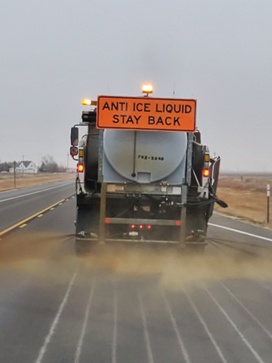Kansas crews using beet juice to help fight ice, snow

When KDOT crews treat highways for ice, especially when it is the coldest, motorists might notice darker trails on the pavement instead of the usual white trails left by brine.
It’s beet juice. It tends to leave a brownish or grayish residue.
Here’s why KDOT sometimes mixes beet juice with brine (saltwater) that it applies to roadways to melt ice or to slow its formation.
–The properties of beet juice, when mixed with brine, allow the melting agent to be effective at lower temperatures. Based on the level of concentration, beet juice mixed with brine can help control ice when it is as cold as around 0 degrees.
Beet juice also allows brine and salt to adhere to pavement longer.
On bridges, which tend to get icy, beet juice bonds to the salt crystals in brine and helps the brine stick to a bridge deck longer, says Jim Frye, Field Maintenance Manager/Emergency Coordinator with KDOT.
Another beet-juice benefit, says District Five District Engineer Brent Terstriep, is that when beet juice is added to brine, the combination makes ice-fighting more efficient because crews don’t have to drive out as often to apply brine.
Frye gave this additional explanation of how beet juice works and how it has been used:
–As moisture on pavement starts to freeze, the juice slows the process so that the liquid remains slushy longer. That gives crews more time to clear highways before the liquid turns to solid ice.
–One problem with spreading salt or spraying salt brine on a highway is that it will bounce away or scatter with traffic or the wind. “When the beet juice is added to the salt or salt brine, with its sticky texture, it will hold the salt or salt crystals on the highway longer, allowing it to work in our favor,” Frye said.
KDOT began experimenting with the beet juice it uses now during the winter of 2015 in northwestern Kansas. Since then, KDOT has made beet juice available at more than 20 locations across Kansas



